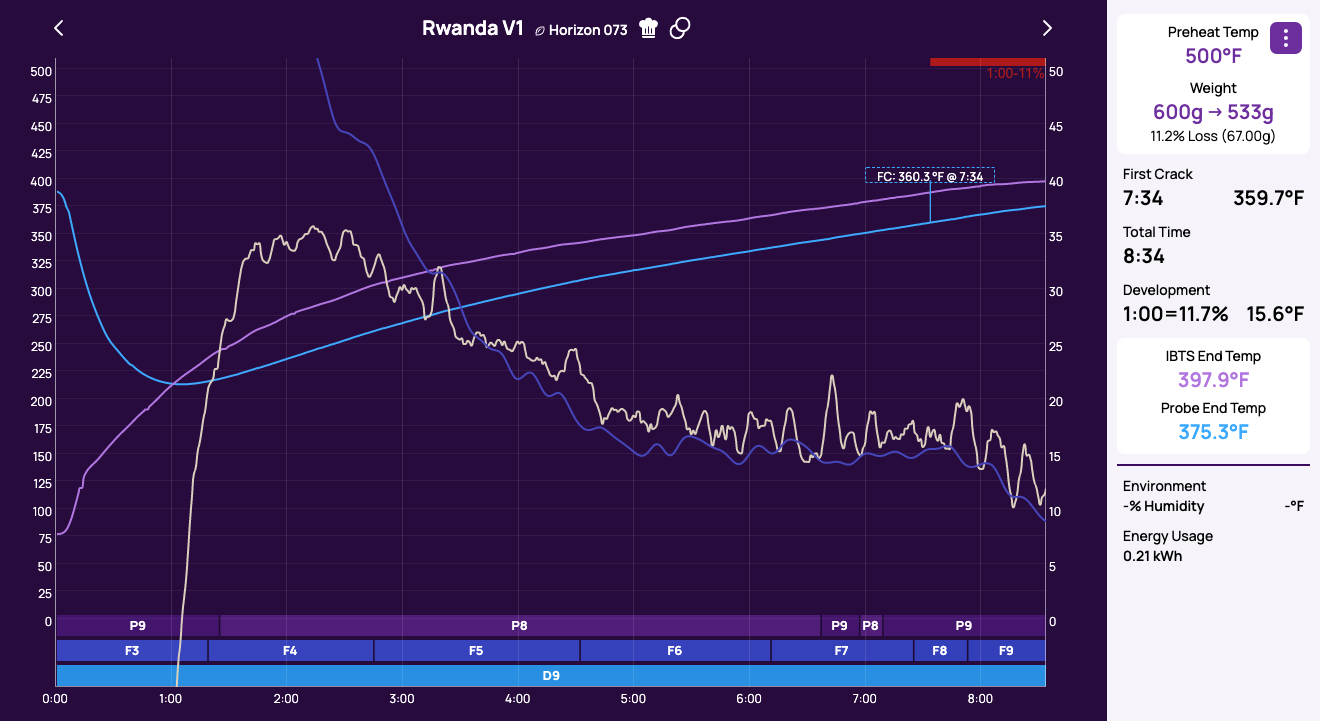(Sold Out) Legacy Bourbon Horizon Rwanda
(Sold Out) Legacy Bourbon Horizon Rwanda
We roast every Tuesday and ship Wednesday. To be in the next batch, place orders by 8:00AM (CST) on Tuesday.
Red Bourbon
Produced by Fidele Ndagijimana / Horizon Supreme Washing Station
Huye, Rwanda
Process - Washed
Later Harvest 2023 / Later Arrival
Tasting Notes - Lingonberries, Raisin Yogurt, Ceremonial Matcha, Tart & Creamy
Flavors Unexplored
Rwanda is a country we personally don’t venture into much as coffee tasters. Same with its neighboring countries of Uganda, D.R. Congo, Tanzania, and Burundi. The effects of political issues, exportation complexities, low-quality robusta varieties, border smuggling for better prices, and coffee diseases have tremendously affected these countries.
With all of these things in mind, I’d imagine it would have been much easier for importers and roaster to access consistently high quality coffees from African powerhouse countries like Kenya and Ethiopia instead, and have the associated price tag attached. Though, over the past few years we’ve seen incredible changes positively affecting accessibility and coffee quality in these countries. Which is why we’re so incredibly excited to explore lesser-known regions/countries and share more unexplored coffees and flavor profiles with you!
Mind Bending Experiences
One of our first introductions to Rwanda was an anaerobically processed Bourbon (similar variety) roasted by Friedhats in the Amsterdam. This coffee was one of our all-time favorite coffees to date as it had a wonderfully lactic texture/flavor with tart yet jammy red fruits and an incredibly intense sweetness you could only get out of a traditional drum-style roast machine. It was a match made in heaven!
We thought it would be fun to sample a few fresh arrival Rwandans along with our favorite African coffees, Ethiopians and Kenyans. After tasting a wide variety of African coffees, we picked our Grand Budapest Breakfast Ethiopian and eventually this one!
To Understand Terroir, You Must Taste It Washed
The only Rwandan coffees we’ve tasted that had serious shock value were all heavily fermented. We had a very narrow idea of what these coffees are capable of since they had not been processed as a washed, without much fermentation, to paint a clearer picture of the terroir and flavor profile this region and country holds.
Since the importers we were working with for these coffees only had washed Rwandans on their menu at the time, we thought this would be a great opportunity to test the waters. If we didn’t like the same, we definitely weren’t expected to purchase 60 kilo bags of this coffee.
Why We Chose Our First Rwandan
Whenever I cup coffees, I look for tastes that surprise me. If the coffees I’m tasting don’t have sparkling, effervescent acidity that represent themselves in a unique way, I simply won’t buy it. To do this, I aim to cup without looking at the price or importers names. I attempt to separate coffees by processing method and region as well so I don’t blow out my palate with an intensely fermented coffee that doesn’t allow me to easily taste nuance in the other more subtle coffees afterwards.
This Rwandan surprised me on the table. It was against quite a few old-crop washed Kenyan coffees that honestly weren’t really great or surprising enough to purchase (sometimes these coffees tend to peak at this time, sometimes they already had or never really did…It’s hard to tell). The Rwandan coffee stunned me with a sparkling effervescence that I always look for in a coffee I’m about to purchase. After a few blind tasting sessions I picked my favorites, again and again and realized we’re about to offer a personally, very unfamiliar coffee!
About Red Bourbon
Likely in the 1300’s, coffee was taken from the wild forests of Ethiopia and brought to Yemen. It is from Yemen that two varieties, Typica and (Red) Bourbon would come to be the parents of most modern coffee varieties, as they would create many, many offshoots. Because of this, it is said that most of coffees flavors come from the soil, plant-nutrition, cherry-ripeness, shade variances, and processing differences rather than the variety themselves. Personally, I do not believe this as i’ve tasted many coffees processed in the exact same way, grown on the same farm, and roasted to the same profile, but the only difference was the variety of plant. Which can often be astonishingly different. After all, because of Bourbon and Typica we have Geisha, along with so many others.
Centuries ago, on September 25, 1715, 60 trees were brought from Yemen, where coffee was first cultivated by humans, to Bourbon Island (now La Réunion) which was a French-occupied Island (believed to be uninhabited most of its existence) that is close to Madagascar in the Indian Ocean. Upon its arrival, only 20 plants survived the journey, and only 3 years later, there was only 1 coffee plant that was producing. 1/60 plants to carry on its lineage was the Red Bourbon variety. By 1718 It had managed to produce over 100 seedlings, and by 1720 it had been able to produce around 7,000 new trees!
Réunion island’s Red Bourbon tree achieved Heirloom status, as they were passed down generationally by hand to non-commercial, private home garden farms. The variety became accustomed to the soil and climate for about 150 years before hitting global popularity as a better, more modern alternative to the Typica variety. Bourbon was then transported again to other parts of the world, around the 1860’s. It wasn't until the very early 1900’s when the first coffee, Red Bourbon arrived and was grown in Rwanda. By the 1930’s and 1940’s Belgian Colonial Government established large scale coffee production in Rwanda, which they made coffee growing mandatory during their rule of the Belgian Congo from 1908-1960. By 1970, coffee had become the largest export of the country and accounted for 70% of export revenue. By 1973, coffee was considered so valuable that tearing coffee trees out of the ground was illegal.
To this day, Red Bourbon plants consist of 95% of Rwanda's coffee production.
*It should be noted that around the 1930’s , in Brazil (8 decades after it was brought to Brazil), there was a natural cross between Red Bourbon and Yellow Botucatu, which was named Yellow Bourbon. Pink Bourbon is also not closely related to the Bourbon family at all, as it’s an unknown variety from the wild forests of Ethiopia. It is suspected that Pink Bourbon might have escaped from the Cenicafé research farm located in Acevedo, Huila, Colombia in the 1980s. A strange series of events (you should look this up!) led to producers calling this variety, Pink Bourbon.
The Land of a Thousand Hills = Legacy Bourbon
Legacy Red Bourbon cultivars straight from the Bourbon Island is the main variety of Burundi (95% of coffee trees here are Red Bourbon), and is responsible for most of the flavor profiles associated with its terroir. Bourbon has been thriving in this country for over 150 years, adapting to the climate just as it did for its previous 150 years on Bourbon Island. It’s incredibly interesting because its almost-neighboring country, Kenya, is responsible for producing SL28/SL34 varieties which stem from the Bourbon-Typica group (though Ruiru 11 is now being heavily used for its root systems in Kenya which is altering the quality. We wrote about it here.). So, in a sense, Rwanda is a unique version of Kenya, where the entire country is founded on a VERY small selection of specific varieties. That means we can taste terroir in a slightly more transparent way, exploring region after region with the same varieties and discovering what each specific region’s terroir is capable of. That’s incredibly exciting to us!
About The Roast
When I tasted this coffee I knew it would allow me to roast in such a way that would easily tell me how I roasted, good or bad. A lot of coffees we purchase have such intense flavor profiles (even washed ones) that you could roast them in so many different ways (but still around a similar profile) and they would almost always taste similar. This coffee had less of that “intensity” we’ve been so familiar with and it would be an honest representation of how we’re roasting with our very unique, and often eye batting profiles. Basically, this would tell me if my ideas suck, or if they could easily be translated across a wide variety of coffees and countries. Add in to the fact that this coffee was only $4.60/pound before shipping fees while also scoring an 88 by our importers and we’re enthusiastic!
You’d imagine my excitement when I found that we roasted this coffee in 3 unique ways and actually favored the very first roast profile. We have developed and use a standardized roast profile curve (heat and cooling effects vary) that works for every single coffee we have every used with it. Also, most of our roasts have been profiled dozens of different ways and actually trace closely with this Standardized profile. So dialing in coffees has been getting incredibly easy for us to atleast get close within a couple tries.
However, we had some very unique and interesting profiles I’d love to talk about. You can view the profiles and their descriptions below. I believe the easiest and one of the greatest/most-dramatic flavor changes you can make as a roaster is by modifying batch size and staying as consistent as possible to the heat and cooling applications while making time and development phases have less importance. Staying as equal as possible to the weight loss percentage, and infrared end temperatures would be ideal (there will be variances in your bean probe). There will absolutely be variances in color as well and should not be considered an issue due to the difference in development (probably more uneven development, i.e. darker on the outside and possibly lighter on the inside in the 500g faster profile) causing this flavor change.
What we taste by doing this (version 01 and Version 02) is incredibly different flavor presentations that both taste incredibly nice in their own unique ways. You can view this below.
First & Final Profile. This profile is incredibly similar to V2 below, though this profile was 600g and V2 was 500g on green. I prefer this coffee because of its cleanliness, vibrant sweetness, and articulate texture and flavor profile.
V2 was our second favorite profile. It’s incredibly textural, with a slight tropical fruitiness and funk that we really enjoy. I think this would be less of an appropriate representation of this coffee because it tends to hide the clear and clean flavors of the Legacy Red Bourbon variety and the Rwandan terroir we spoke so highly about in the above sections. This is a personal choice that I think reflects the delicacy of this situation.
V3 was just too roasty. As you can see, we tried a different heating and cooling approach that are more in line with typical roasting styles. We also stretched out the post first crack development phase quite a bit more than the other two profiles. I’d be interested to see what this profile would taste like if we roasted it with less development time.





